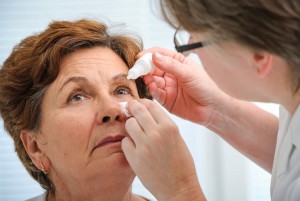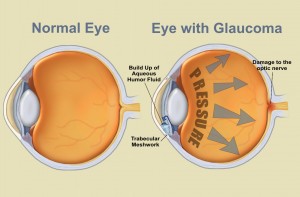Treating Glaucoma
Glaucoma is a disease where there is progressive damage to the optic nerve, which is the major nerve associated with vision. This damage can first cause a subtle loss of peripheral vision, and can possibly progress to a loss of central vision and even blindness.
Glaucoma is the second leading cause of blindness, worldwide. It is estimated that more than 3 million people in the U.S. have glaucoma, with up to half not realizing they have the disease. Glaucoma may initially cause no symptoms, with the subtle loss of peripheral vision often not recognized.
Causes of Glaucoma
The main cause of glaucoma is elevated pressure in the eye. The optic nerve, located in the back of the eye, is the main visual nerve for sight. The optic nerve is susceptible to high pressure because its delicate fibers can be easily damaged. There is a continuous process that occurs where fluid is produced and then removed from the eye. In some people, the drainage channels in the eye may be narrow, causing a ‘clogging’ of fluid and thus elevation in what is called intraocular pressure, the pressure level within the eye. An elevation of pressure outside the norm can cause optic nerve damage.
Glaucoma is especially dangerous because intraocular pressure can build up and damage sight without very obvious symptoms. For this reason it is critical that glaucoma be diagnosed early. There are several risk factors for glaucoma, including: 45+ years of age; nearsightedness; farsightedness; use of cortisone; history of eye injury; and black racial ancestry.
Type of Glaucoma
Glaucoma is normally classified as either open-angle glaucomas, which are usually chronic; or closed angle glaucomas, which can include acute and chronic.
- Open-angle glaucoma: By far the most common type of glaucoma, its frequency increases with age. The eye drainage channel become clogged over time, resulting in the aqueous fluid failing to properly drain from the eye. Pressure builds up and can cause gradual loss of vision.
- Normal tension or low tension glaucoma: Variants of the chronic open-angle glaucoma, it is thought to be due to decreased blood flow to the optic nerve. The result is progressive optic-nerve damage and loss of peripheral vision.
- Congenital glaucoma: This condition is relatively rare, and occurs when the eye drainage area is not properly developed before birth. It is critical to diagnosis and treat this condition early.
- Secondary open angle glaucoma: This condition can be caused by an eye injury, inflammation in the iris of the eye, diabetes, cataracts or the use of steroid medications.
- Pigmentary glaucoma: This type of glaucoma, more common in younger men, occurs when granules of pigment detach from the iris and block the drainage system in the eye.
- Exfoliative glaucoma: This type can be with either open or closed angles. It is characterized by the front of the lens and the angle of the eye. The material accumulates and blocks the eye dAqurainage system.
- Angle-closure glaucoma: This condition, often found in people in Asia, occurs when a portion of the drainage angle becomes closed. The patient’s intraocular pressure can rise very actutely, as the drainage angles close and block of all drainage channels. People with smaller eyes can have a higher likelihood of developing angle-closure glaucoma.
Diagnosing Glaucoma
An ophthalmologist is usually able to detect people at risk for glaucoma before nerve damage occurs. There are a number of tests available to assess eye pressure, cornea thickness and the optic nerve. The doctor may also examine the drainage canal for abnormalities. The American Academy of Ophthalmology recommends the following protocol for eye exams.
- Ages 20-29: People of African descent or with a family history of glaucoma should have an examination every three to five years. Others should have at least on exam in this age period.
- Age 30-39: People in the high risk categories, should have an eye exam every two to four years. Others should have at least two exams during this age period.
- Age 40-64: All individuals should have an exam every two to four years
- Ages 65 or older: All individuals should have an eye exam every one to two years
Routine screening examinations are mandatory since they are usually no symptoms in the early stage of glaucoma. It is critical that glaucoma be identified and treated early, as damage to the optic nerve cannot be reversed.
Treating Glaucoma
As long a glaucoma is identified and treated early, it can usually be controlled. Treatments options include eyedrops, pills, laser and surgery.
Eyedrops: There are several different types of eyedrops that are used to treat Glaucoma. Beta-adrenergic antagonists work by reducing production of the aqueous humor. Betaxolol is a beta-adrenergic antagonist that is more selective in working just on the eye and carries less side effect risk. Prostaglandin analogs, hormone-like substances involved in a wide range of the the bodies’ functions, work by increasing the drainage of fluid from the eye. Adrenergic agonists are drops that act like adrenalin, and benefit by reducing the production of fluid and increasing drainage in the eye. Carbonic anhydrase inhibitors work in glaucoma by reducing the production of fluid in the eye. Parasympathomimetic agents work by increasing the aqueous outflow from the eye. Osmotic agents are a class of medications used to treat acute forms of glaucoma, where the eye pressure remains high despite other treatments.
Laser Therapy: There are several forms of laser therapy to treat glaucoma. Laser iridotomy is a laser procedure where a hole is made in the iris to allow fluid to drain normally. Laser trabeculoplasty is used to lower the intraocular pressure in eyes with open angles only. The procedure is performed in two sessions weeks or even months apart. Laser cyclo-ablation is a laser treatment used on people with severe glaucoma with poor visual potential. In this procedure, laser burns or freezing is applied to the part of the eye that makes the aqueous fluid, destroying the cells that make the fluid and thus reducing eye pressure.
Surgery: Surgery is also an option to treat glaucoma and normally considered for glaucoma cases that cannot be controlled with other treatment options. Trabeculectomy is a microsurgical procedure where a small piece of the clogged trabecular meshwork is removed to create an opening and a new drainage pathway is made to for fluid to drain from the eye. Aqueous shunt devices (implants or tubes) are artificial drainage devices that are placed in the eye to improve drainage and thus reduce eye pressure. Viscocanalostomy, canaloplasty, and the trabecutome are alternative surgical procedures that involve creating openings in the trabecular meshwork. These are less invasive then other surgical options but may not be as effective.
To learn more about glaucoma and treatment options, schedule a consultation with our experts at White Plains Eye Surgery.



